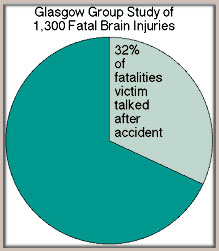No Reported Loss of Consciousness. How Do We Know There Wasn’t a Loss of Consciousness?
 No Witnesses?
No Witnesses?- Delayed Loss of Consciousness?
- Problems with ER
- Rely on Injured Brain for History Taking
- Symptoms Get Worse Over Time
- Second Look At Medical Records
- Lawyers Role
In most cases of TBI without coma, the emergency room records will say “no reported loss of consciousness.” But how do we know there wasn’t? The emergency room personnel are never at the scene, and there usually is at least a half hour gap between the time of the accident and the patient’s arrival at the hospital. Who was there during the critical moment to tell?
If the only person who is asked whether there was a LOC is the patient, then the report in the emergency room record that there was no reported loss of consciousness, is of little significance. The injured person is a particularly poor historian of events for something that occurred when they may have been unconscious, disoriented or suffering from amnesia.
A Second Look at the Medical Records.
While you don’t rely on the medical records, you don’t ignore them either. The clues are often there, especially in the ambulance records. Is there a reference to disorientation, nausea, or the need for oxygen in ambulance records? Is what the patient said to the ambulance attendants with respect to symptoms and the events of the accident, consistent with what the patient told the ambulance attendants?
The Lawyer’s Role.
By way of the lawyer’s training and expertise in interrogation, the lawyer can often get a better sense of whether there was an LOC. Do a detailed questionnaire with respect to accident facts. Very carefully, walk the client through the accident details. Go back over the details several times, each time telescoping the time sequenced, getting more and more precise as to exactly what is happening just before impact, and just after the vehicles come to a rest. Watch for “the next thing I remember.” Can the client give you a complete history, or are there jumps? What did the crash sound like? It is significant if the injured person cannot remember something as loud as the sound of the crash? In a surprising number of cases, there will be a gap in memory, if not consciousness.
Emergency Room Misdiagnosis